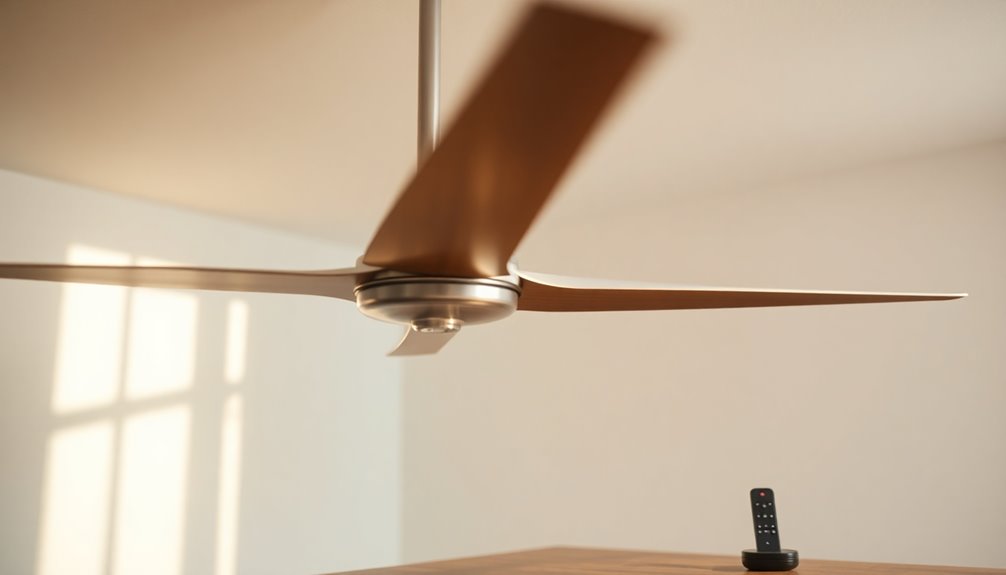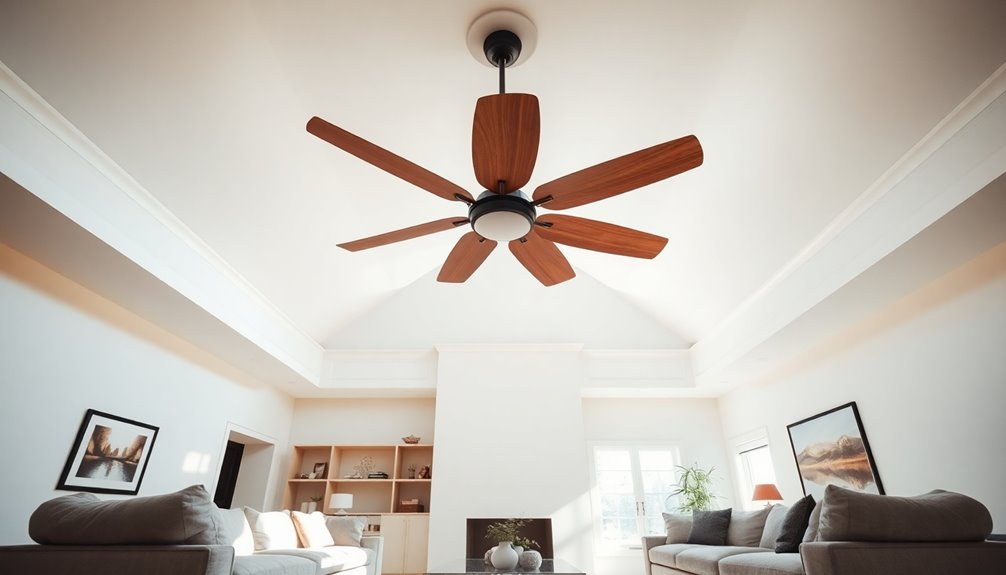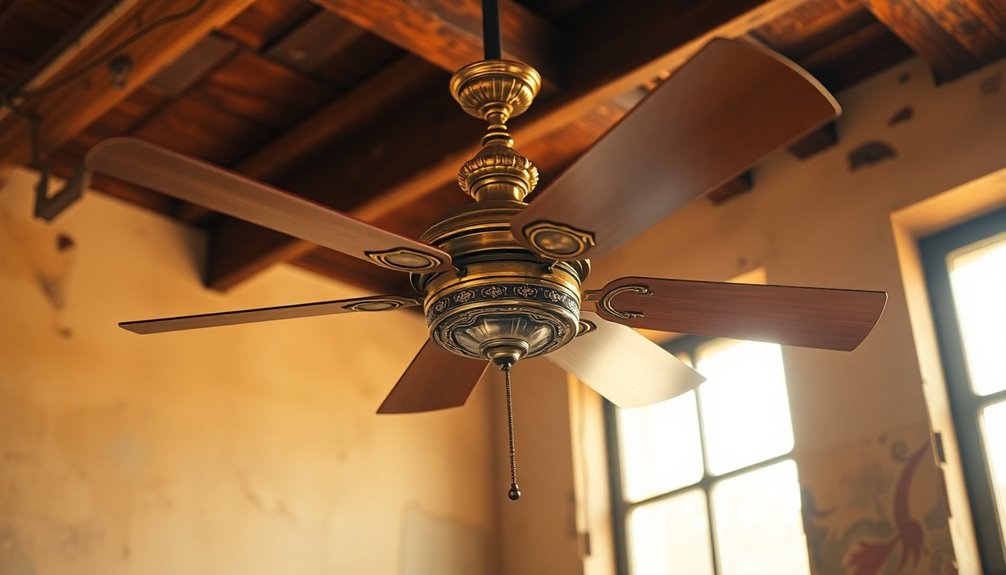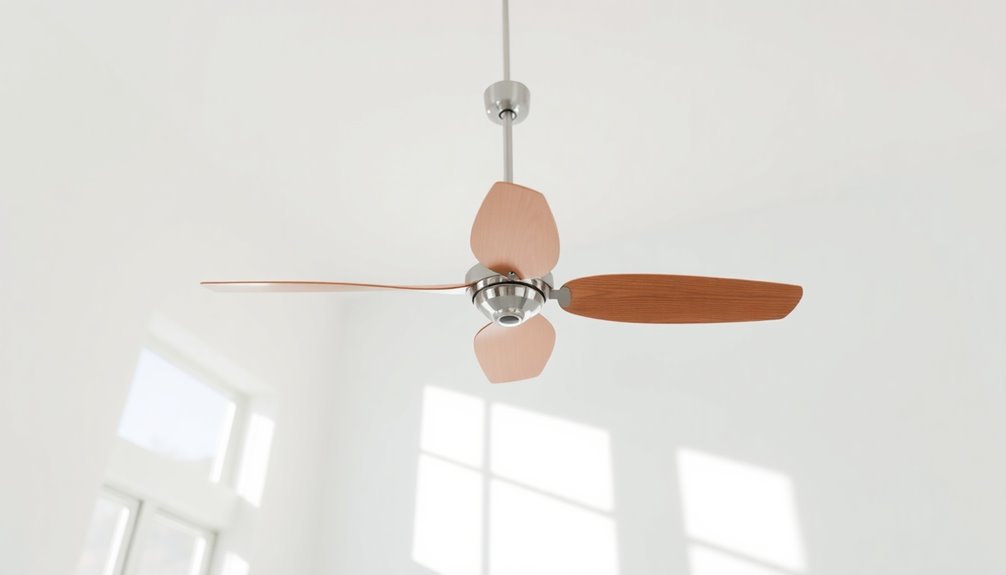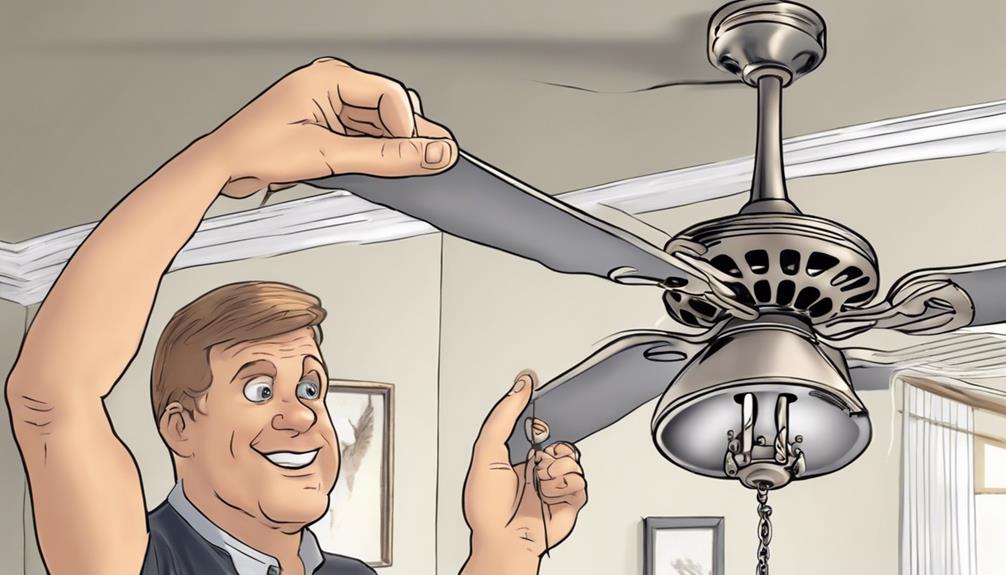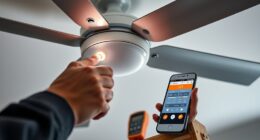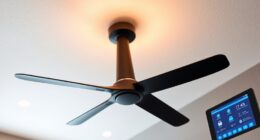If your ceiling fan turns on by itself, it could be due to several factors. You might be experiencing remote control interference from nearby devices or other electronics. Loose wiring connections can also cause erratic behavior, while a malfunctioning pull switch may inadvertently complete the circuit. Additionally, smart home gadgets or environmental factors can trigger the fan. It's crucial to inspect these elements for any issues. By addressing these common causes, you may find a solution to your frustration. There's much more to discover about troubleshooting and potential fixes for your fan's unexpected activation.
Key Takeaways
- Remote control interference from nearby devices can inadvertently activate the ceiling fan.
- Loose wiring connections may lead to an intermittent power supply, causing the fan to turn on unexpectedly.
- A malfunctioning pull switch can result in unintentional circuit completion, activating the fan.
- Environmental factors like drafts or vibrations from appliances might trigger the fan to turn on by itself.
- Adjusting dip switch settings on the remote and receiver can help prevent communication issues and unintended activation.
Common Causes of Activation

Ceiling fans can sometimes turn on by themselves, and there are several common causes behind this unexpected behavior.
One major culprit might be interference from neighboring remote controls. If your fan's remote control operates on a similar frequency as someone else's device, you could find your fan unexpectedly responding to their commands.
Another issue could stem from electronic devices nearby, like smart home gadgets or garage door openers. These devices can inadvertently trigger your fan's remote control, leading to activation without your input.
Additionally, loose wiring connections within the fan can result in an intermittent power supply. This fluctuation can cause the fan or lights to turn on erratically. If you notice that the pull switch for the light is malfunctioning, it might be completing the circuit without your intent, often due to wear and tear from frequent use.
Lastly, environmental factors like drafts or vibrations from nearby appliances can also play a role, causing your fan to start up unexpectedly.
Troubleshooting Your Ceiling Fan
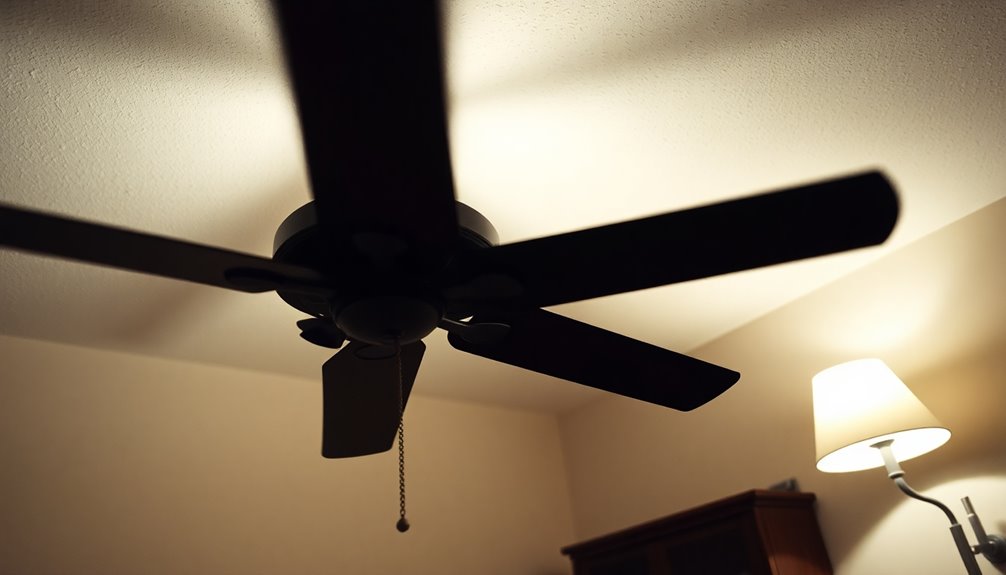
If your ceiling fan keeps turning on by itself, it's time to troubleshoot.
Start by checking for interference from other devices and inspecting the pull switch for any defects.
Additionally, verify all wiring is secure and consider resetting the fan to eliminate any electronic glitches.
Common Causes Explained
Unexpected ceiling fan activation can be frustrating, but understanding the common causes can help you troubleshoot the issue effectively. One frequent culprit is interference from nearby remote controls or electronic devices that operate on similar frequencies. This can lead to unintended control signals activating your fan.
Another potential cause is a defective pull switch. If it's malfunctioning due to overuse, you might notice erratic behavior in the ceiling fan light, which can be mistaken for spontaneous activation.
Additionally, loose wiring connections within the fan can disrupt the power supply, resulting in intermittent operation or unexpected activation of both the fan and lights.
It's also important to regularly inspect and replace light bulbs. Faulty bulbs nearing the end of their life may flicker or turn on unexpectedly, adding to your confusion.
Finally, if you're using a remote control, adjusting the dip switches on the remote and receiver can resolve interference issues, ensuring your fan responds correctly to its designated remote.
Effective Troubleshooting Techniques
When troubleshooting your ceiling fan, start by identifying potential interference from nearby remote controls or electronic devices. Similar frequencies can inadvertently trigger the fan's operation, so check if any devices are close by.
Next, inspect the wiring connections for any loose or damaged components; these can cause intermittent power supply and lead to the fan turning on by itself. If you suspect a temporary glitch, reset the fan by turning off the power for a few minutes.
Refer to the installation manual to adjust dip switch settings on the remote and receiver; mismatched settings can create communication issues that result in unintentional activation.
Lastly, regularly replace light bulbs to eliminate defects that may cause erratic behavior in the fan. Additionally, ensuring proper fan energy efficiency can help prevent electrical issues that might lead to malfunction.
Here's a quick reference table to keep in mind:
| Issue | Solution |
|---|---|
| Remote interference | Move devices away |
| Wiring issues | Inspect for loose connections |
| Glitchy behavior | Power reset |
| Dip switch mismatch | Adjust settings |
| Defective bulbs | Replace with new ones
Manufacturer Guidance and Support

Manufacturer guidance and support are essential resources for troubleshooting ceiling fan issues, like unexpected activation. When your fan turns on by itself, tapping into these resources can make a big difference.
Here are some steps you can take:
- Check the Manufacturer's Website: Look for the installation manual, which often includes troubleshooting sections specific to remote control settings and adjustments.
- Review User Manuals: These can provide insights on adjusting dip switch settings to prevent interference from neighboring devices.
- Explore Troubleshooting Tips: Many manufacturers offer detailed tips for common issues, including random activation of ceiling fans.
- Contact Customer Support: If you can't resolve the issue through standard troubleshooting, reaching out for personalized assistance can be invaluable.
Additionally, don't forget to check for any firmware updates or recalls announced by the manufacturer, as these can address known issues with specific fan models.
Leveraging manufacturer guidance and support not only helps you tackle the problem effectively but also guarantees your ceiling fan operates smoothly.
Community Insights and Solutions
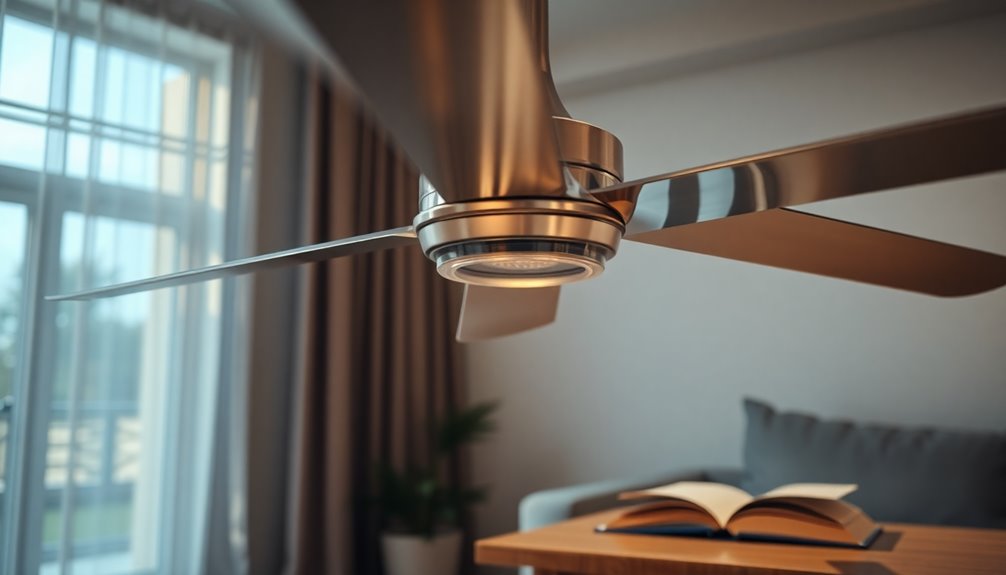
Many users have faced the frustrating issue of ceiling fans turning on by themselves, and community insights can be a valuable resource for finding solutions. One common cause reported is interference from neighboring remote controls. If you've noticed your fan activating unexpectedly, consider whether other electronic devices, like smart home gadgets, might be triggering it. Additionally, some people have discovered that high pressure from nearby devices can contribute to these activations.
Many users suggest a simple fix: reset the fan by cycling the power. This quick step has often proven effective in resolving random activation issues. Additionally, adjusting the dip switch settings on both the remote and the fan's receiver can help eliminate interference, ensuring better communication between the devices. It's also important to consider that smart home integrations can sometimes affect how devices operate together.
Engaging with fellow users in online forums can also provide tailored advice specific to your fan model. You might find that others have experienced similar quirks and can share solutions that worked for them. Furthermore, understanding the importance of energy-efficient technology can help you choose fans that are less prone to such issues.
Configuring Remote Control Settings
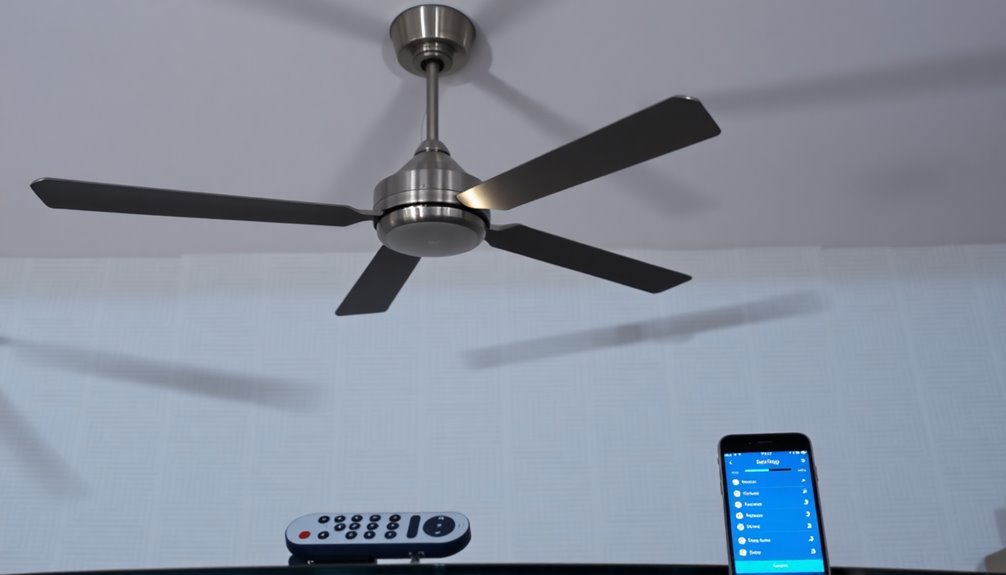
When configuring your ceiling fan's remote control settings, start by adjusting the dip switches for a unique pairing.
Make sure the settings on your remote match those on the fan's receiver to avoid interference.
If you're still having trouble, experimenting with different combinations can help you find the right frequency.
Dip Switch Configuration
Configuring the dip switch settings on your ceiling fan's remote control is essential for guaranteeing seamless communication between the two devices.
Dip switches act as a pairing mechanism, allowing the fan and remote to operate without interference. To set this up correctly, follow these steps:
- Locate the Dip Switches: Find the dip switch panel on both the remote control and the ceiling fan's receiver.
- Check the Settings: Verify that the dip switch settings match between the remote and the fan. This typically involves 4 to 8 switches.
- Change to Unique Combinations: If you suspect interference from nearby devices, select a unique combination. This helps avoid frequency conflicts.
- Test Multiple Combinations: If your fan still misbehaves, try different combinations of dip switch settings. Successful pairing usually occurs within two attempts.
Some brands, like Hampton Bay, may have pre-programmed settings, so be sure to verify compatibility.
Properly configuring the dip switch can resolve issues, guaranteeing your ceiling fan operates as intended.
Remote Pairing Process
To secure your ceiling fan operates smoothly with the remote control, you'll need to go through the remote pairing process. This involves adjusting dip switches in both the remote and the fan's receiver. Each dip switch has multiple positions, usually between 4 and 8, and you must set them to unique combinations to avoid interference with nearby fans.
Here's a simple table to visualize the dip switch combinations:
| Dip Switch Position | Remote Control | Ceiling Fan Receiver |
|---|---|---|
| 1 | ON | OFF |
| 2 | OFF | ON |
| 3 | ON | ON |
It's essential to change the default factory settings during installation to avoid multiple fans activating at once. Pairing typically succeeds within two attempts, so if it doesn't work initially, try different combinations. Keep in mind that some brands, like Hampton Bay, may come pre-programmed with fixed settings, limiting your adjustment options. Following these steps will help guarantee a seamless connection between your remote and ceiling fan.
Frequency Adjustment Tips
Adjusting the dip switches on both your remote control and ceiling fan can greatly enhance their performance and reduce interference.
These dip switches act as a unique "password" for your devices, allowing them to communicate effectively. Here are some tips to configure them correctly:
- Locate the Dip Switches: Find the dip switches in both the remote control and the ceiling fan's receiver. They usually consist of 4 to 8 toggle switches.
- Change the Default Settings: It's crucial to modify the factory settings during installation. This prevents accidental activation from nearby devices using similar frequencies.
- Experiment with Combinations: If your fan still turns on by itself, try different combinations of dip switch settings. Successful pairing often happens within a few attempts.
- Refer to Manufacturer Guidelines: Always check the manufacturer's instructions for specific dip switch adjustments. Some brands have pre-programmed settings that you may not be able to change.
When to Seek Professional Help
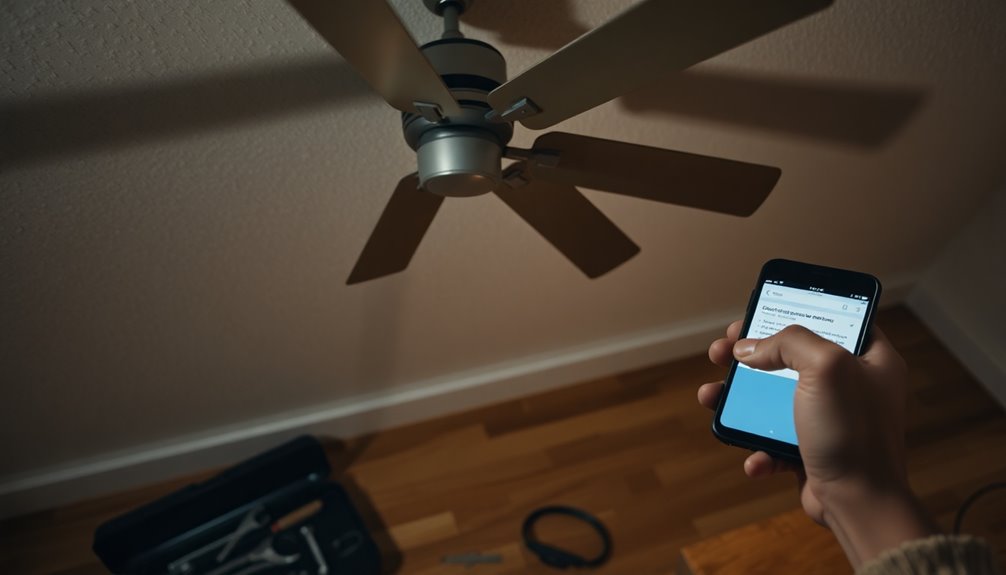
When your ceiling fan turns on by itself despite your troubleshooting efforts, it's time to contemplate seeking professional help. This recurring issue might signal deeper electrical problems that require an expert's evaluation.
If you notice signs like overheating, burning odors, or frequent trips of the circuit breaker, these are critical indicators that immediate assistance is needed. Ignoring these signs can lead to potential hazards, putting you and your home at risk.
If your ceiling fan is controlled by a remote, the complexity of the wiring might be even greater, especially in older homes with multiple interconnected devices. Dealing with electrical systems can be tricky, and unfamiliarity can lead to unsafe situations.
It's better to seek help from a licensed electrician rather than attempting repairs yourself. Consulting a professional not only guarantees safety but also provides peace of mind. Additionally, an electrician can evaluate the situation to ensure there are no underlying electrical issues that could pose further risks.
They can identify and fix underlying issues effectively, keeping your ceiling fan and your home safe. Don't wait until a small issue escalates; if your ceiling fan keeps acting up, reach out for professional assistance sooner rather than later.
Frequently Asked Questions
What Would Cause a Fan to Turn on by Itself?
Several factors could cause your fan to turn on by itself.
You might experience interference from nearby remote controls, especially if they share similar frequencies.
A defective pull switch could malfunction, completing the circuit unintentionally.
Additionally, check for loose or damaged wiring, as this can lead to intermittent power supply.
Environmental changes like drafts or temperature shifts might also influence its operation.
Finally, verify your fan's internal settings are correctly adjusted.
Why Is My Ceiling Light Turning on by Itself?
If your ceiling light's turning on by itself, you might want to check a few things.
First, it could be due to a defective pull switch or loose wiring connections causing erratic behavior.
Also, nearby electronic devices might interfere with the remote control frequency.
Finally, flickering lights could signal that the bulbs are wearing out and need replacing.
Regular maintenance can help you avoid these unexpected activations.
Why Does My Hunter Ceiling Fan Turn on by Itself?
Did you know that nearly 25% of ceiling fan issues stem from electrical interference?
If your Hunter ceiling fan turns on by itself, you might be facing one of several common problems. It could be due to interference from nearby remote controls or misconfigured dip switches.
A malfunctioning pull chain switch or loose wiring could also be the culprit.
Regular maintenance checks can help guarantee your fan operates smoothly and doesn't activate unexpectedly.
How Do I Change the Frequency on My Ceiling Fan Remote?
To change the frequency on your ceiling fan remote, start by locating the dip switches in both the remote and the fan's receiver.
You'll usually find 4 to 8 switches. Make sure the settings match exactly to avoid interference.
If you're experiencing issues, try changing the combination to a unique setting.
Check your fan's installation manual for specific instructions on accessing and adjusting the dip switches, as configurations can vary by brand.
Conclusion
In the dance of air and light, your ceiling fan shouldn't waltz on its own. If it spins unexpectedly, remember to check for common culprits and troubleshoot with a keen eye. Don't hesitate to reach out to the manufacturer or tap into community wisdom for solutions. If the mystery persists, seeking professional help could be your guiding star. With a little patience, you'll restore harmony to your space, where the only movement comes from you.
